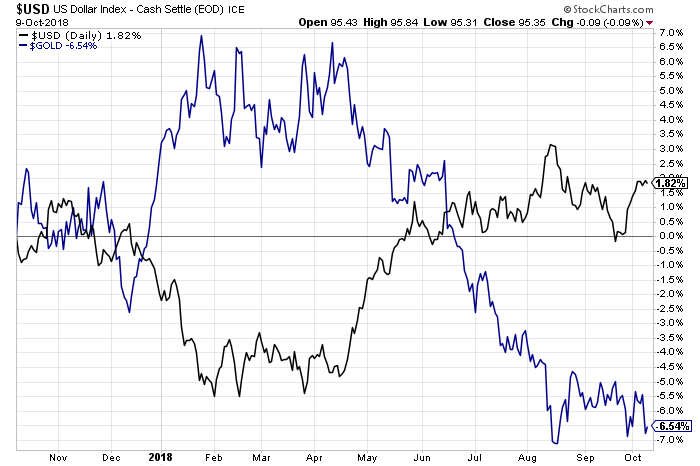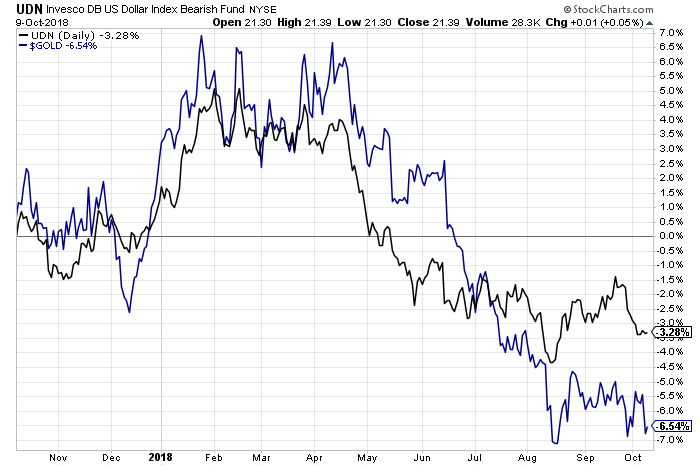Gold is deemed an essential piece of the asset allocation pie in some corners. The reasons vary, depending on the investor, although it’s not uncommon to hear rationales that sound more like religious sermons on the mystical properties of the yellow metal. From an econometric perspective, gold’s attributes for portfolio design are relatively ordinary by way of closely aligning with the inverse return of the US dollar. As such, using gold in portfolios can and arguably should be viewed as a quasi-forex trade as opposed to an all-weather hedge that can never go wrong.
Thinking of gold as another means of tapping into foreign currency exposure can be an eye-opening revelation for some investors who would otherwise steer clear of forex risk in their portfolios. But recent history speaks volumes.
Consider the performances of the US Dollar Index vs. gold over the trailing three-year period through yesterday’s close (Oct. 9). As the chart below shows, the two prices largely move inversely to one another.

Recent history is no anomaly. In the next chart, regressing one-year percentage changes for gold against the dollar (a basket of foreign currencies) reveals a moderately inverse relationship since 1980: the R-squared for the regression (red line) is 0.33 and the p-value is virtually zero, indicating a robust linkage.

In essence, holding gold is a bet on a weaker dollar. The history of the metal provides the logic for this connection. Gold, after all, was formally used as money for centuries and the legacy endures, despite the fact that the global economy fully switched to fiat money in the early 1970s. Reasonable or not, many investors still consider gold as a hard-money alternative to the world’s reserve currency, which explains the dance between the two assets.
The question for investors intent on maintaining a dedicated allocation to gold, either through a fund or owning the metal outright: Is this the equivalent of a short-dollar bet? Yes, at least to a degree. In turn, this view of gold raises another question: Do you really want a short-dollar allocation?
If the answer is “yes,” a reasonable follow-up question: Should you drop the veneer of holding “real money” and instead focus directly on the risk factor that’s bound up with your decision? In other words, is there a stronger case for holding a short-dollar ETF via PowerShares DB US Dollar Bearish (NYSE:UDN) in place of gold?
It’s a reasonable question when you consider the next chart, which reminds that UDN has been a proxy for gold.

To round out this point, let’s add that PowerShares DB US Dollar Bullish (NYSE:UUP) delivers the inverse to UDN and therefore gold.

The point is that rethinking gold’s role in asset allocation in forex terms may lead you to recognize that the US dollar is the real source of the risk in play. Owning gold is the equivalent of shorting the dollar, which suggests that a zero-allocation allocation to gold is a phantom long position in the greenback.
Unpacking gold’s role in portfolio design in this manner may disrupt the financial romance that’s often associated with buying the precious metal. But giving up a compelling narrative in exchange for clearer thinking on the risk-factor front is a reasonable trade. If you agree, then the only gold question of relevance boils down to: Do you want to go long or short the buck?
